|
The Mystery of Ancient America's
ViewZone will attempt to give you all the details. Familiar shapes but something's missing.
For the next location we report to the Department of Forestry where we pick up a key that unlocks a gate to protected land on the Colorado and Oklahoma border. The site is located in the Comanche National Grasslands and access to the petroglyphs is restricted to research. Again, our host, Bill McGlone has made all the arrangements and our visit has been anticipated by the authorities.
We travel about a hundred miles on dusty unpaved roads and arrive at the gate in the heat of high noon. The landscape is familiar to us. We are presented with a large flat plaza, surrounded by tall sheer cliffs. A small stream meanders through the plaza and there is ample vegetation and signs of recent cattle grazing. This is another ideal habitat and a possible center for a clan or tribe.
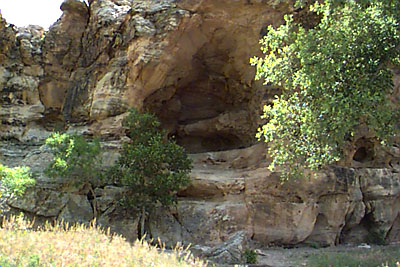 We spot our first petroglyphs easily. Called "the arena" on Bill's map, the site consists of a scooped out cave that has a large collection of vertical slash marks. These marks are very similar to those on the elk wall that we saw and appear to have been made over a period of time, perhaps with different tools. This could very well be connected to the same people that made the elk wall petroglyphs.
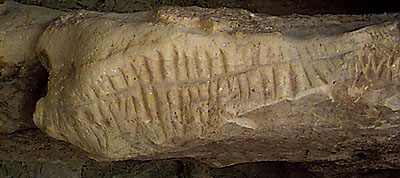 We look closely for the pecked shape of elk antlers, as we found in the previous site, but there are none. The slashes appear to have been made on protruding horizontal section of the cave wall. There is little other art except for a few small quadrupeds that look like cattle in the Plains Indian style. Much of the interior of the cave is crumbling and breaking away from the cliff. If there was anything to offer a clue as to the intent of these rows of scars, it has long since turned into rubble. We continue searching along the cliff walls and eventually come to a barbed wire fence that marks the Oklahoma border. Crawling under the fence we follow the map to a huge collection of boulders. There, among the rocks, we find a flat topped one with many smooth scoops on it. This is "metate rock," a place where the people of the past ground their corn and other grain into flour. These smooth depressions (metates) were made by years of scraping and mashing with a special stones called a manos (literally "hand"). There were many such depressions on this one rock and the signs of age were obvious.
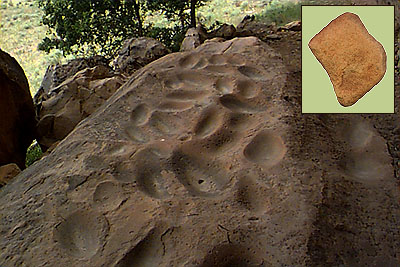 Corn and seeds were ground to flour in these stone mortars. Rounded stones called a "manos" (inset in photograph) were used to mash the material in these worn depressions.
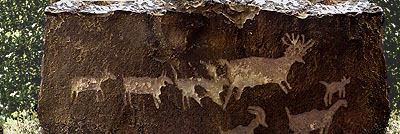
What we do not see in this location is evidence of the Thamudic writing or, in fact, any of the symbols that have been associated with it. This site appears to contain Plains Indian petroglyphs and perhaps some older culture that utilized the circle and elk motifs. Our map has one remaining stop to visit. Will this next site solve some of these mysteries or just leave us with more questions? We are anxious to return to La Junta and to show Bill McGlone our findings. Perhaps he will be able to explain what we have seen.
|


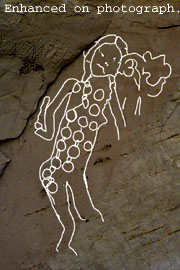 Her hair style and slim body give little clues except that she is literally adorned with circles, many of which are interconnected with lines and other circles. If this is of Plains Indian origin, then the circle motif was familiar to them. In fact there was a rumor that this figure was used by the Plains Indians as a fertility site.
Her hair style and slim body give little clues except that she is literally adorned with circles, many of which are interconnected with lines and other circles. If this is of Plains Indian origin, then the circle motif was familiar to them. In fact there was a rumor that this figure was used by the Plains Indians as a fertility site.